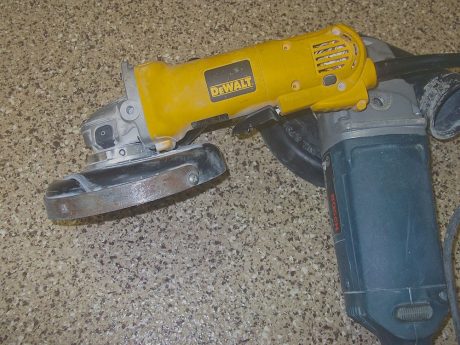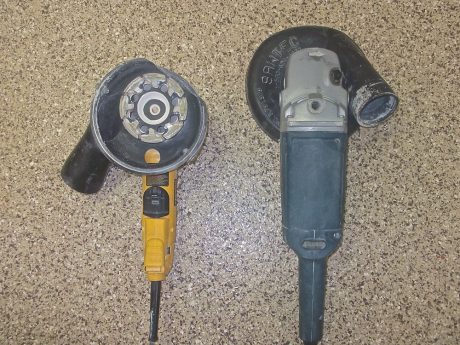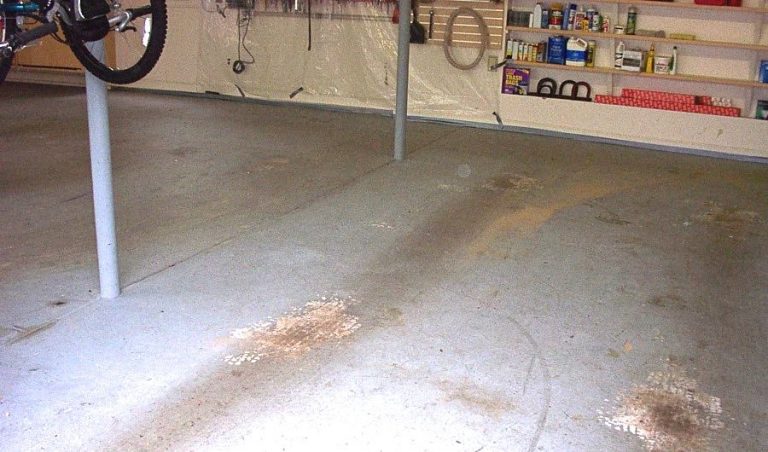Peeling? Flaking? No, I’m not writing about sunburn: I’m writing about a beautiful brand-new garage coating system meeting the family truckster’s sticky tires. Many DIY’ers have attempted this “easy” upgrade to their garage floors. It looks nice on day one, but it’s not long before the peeling starts. “I did exactly what the directions told me to do!” So, what went wrong? If you’re thinking about doing an epoxy flooring project, you’ll want to read on whether it’s a DIY job or something you’re hiring a pro to do.

Why You Might Want to Drop Acid
In the wise words of Chip Monck, Woodstock circa ‘69, “the brown acid is not too good,” and the same applies 46 years later. DIY coatings suppliers recommend using muriatic acid to etch the concrete surface. Once the acid has reacted with the components of the concrete, it is removed and “neutralized” by power washing. I’m not going to go into the hazards of dealing with acids. Let’s all agree they exist and if you go down this road prepare to protect yourself, your kids, and Fido from exposure. Just say NO to acid hazards! In addition, power washing the concrete can force moisture into the very pores you are attempting to bond to. Most resins are oil based and we all know oil and water don’t mix.
The best way to prepare concrete for a garage coating system is through mechanical preparation. Mechanically removing the upper layer of concrete opens the pores in the slab. Additionally, the grinding process grooves the concrete surface creating additional bonding points, which translate to longevity.

Epoxy Flooring Surface Preparation Basics
Many mechanical options exist, but for the DIY’er prepared to put a little elbow grease into getting something right, this task is doable if you’re comfortable working with a grinder. You may have some of the tools on hand and with a couple modifications be up and running in no time. Right angle grinders are readily available and come in both 7 inch and 4 – 1/2 inch options. Walk behind grinders can also be rented and create less fatigue. With a large project, a walk- behind grinder is worth the rental. But, with a pair of kneepads and a frosty beverage break appropriately timed, the right angle grinder is my recommendation for most typical / smaller jobs. The image below is a 4 -1/2 inch right angle grinder with a dust shroud. A 4 -1/2 inch grinder, though smaller than its 7 inch cousin gets the job done, once again proving it’s not the size of the unit but how you use it. The seven inch grinder with shroud and diamond wheel can weigh in at about 17 pounds and gets cumbersome to wield, you know, much like a broad sword on the field of battle.
This unit, in conjunction with a diamond cup wheel and your shop vac freshly equipped with new filter, will get your average 20 x 20 foot garage prepared in less than a day with time left to apply your first layer of coating. No acid burns, no toes removed from power washing and no dry time!

Go Dustless with a Grinder Shroud and Vac
The Internet is a great source for locating dustless shrouds for right angle grinders and can go for as little as $27.95. Some are universal but others use the existing holes of the grinder to attach the shroud. Just be sure to know which model grinder you have to match the right shroud. Concrete dust is nasty, unhealthy and invasive stuff. I would say dust control on a job like this isn’t optional.
Sprucing up the garage with a coatings system can add great appeal and can really finish off a space. Having that system flake off is just like having bad sunburn: it hurts, looks foolish, and your friends will probably make fun of you. Put some extra sweat equity into the preparation, follow the manufacturer’s recommendations for whatever epoxy flooring product you’re using, and you’re on your way to having a beautiful garage floor that will hold up over time.


My current concrete floor is the kind the has a really small set of lines, like decoration on the floor placed while it was drying, I’m trying to make it flat with the grinder as you mentioned, how many diamond cup wheels do you think I might need to buy for a two car garage… this is an open roof garage.
Thank you!
Probably only one. They last a loooonngggg time….
Going down on a concrete floor, been down before so what the heck, will give it a go.
I agree with Robb! Using muriatic acid to etch the concrete surface is also a tip I hear for a first time. Thanks for sharing!
Excellent advice Brett. I use the same setup to prepare concrete for tile. Many time there is a spray coating that concrete guys use that tile (and other things) don’t like to stick to. So if there is any doubt I will break out the ole grinder w/shroud and duct tape it to the shop vac, grab the ole N95 mask, and go to town. Oh, and of course a good set of knee pads and ear protection, as well as eye protection.
I’m kind of inspired to do something with our garage floor now. Ahh, so many projects, so little time….
Thanks for the kind words Scott (and prudent safety tips)! Glad we inspired you to possibly tackle the garage floor. Let us know how it goes!
I have considered applying a coating to my garage, but I never thought of using a grinder for prep. This is great advice!
Thanks Robb!